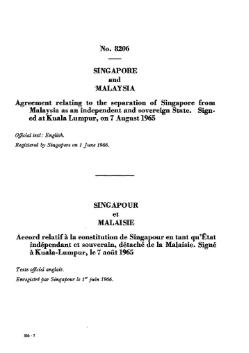
East Malaysia, or the Borneo States, also known as Malaysian Borneo, is the part of Malaysia on and near the island of Borneo, the world's third-largest island. East Malaysia comprises the states of Sabah, Sarawak, and the Federal Territory of Labuan. The small independent nation of Brunei comprises two enclaves in Sarawak. To the south and southeast is the Indonesian portion of Borneo, Kalimantan. East Malaysia lies to the east of Peninsular Malaysia, the part of the country on the Malay Peninsula. The two are separated by the South China Sea.

The Federation of Malaya, more commonly known as Malaya, was a country of what previously had been the Malayan Union and more previously, British Malaya. It comprised of eleven states – nine Malay states and two of the Straits Settlements, Penang and Malacca. It was established on 1 February 1948.

The United Malays National Organisation ; abbreviated UMNO or less commonly PEKEMBAR, is a nationalist right-wing political party in Malaysia. As the oldest national political party within Malaysia, UMNO has been known as Malaysia's "Grand Old Party".
The states and federal territories of Malaysia are the principal administrative divisions of Malaysia. Malaysia is a federation of 13 states (Negeri) and 3 federal territories.

Independence Day, also known as National Day, is the independence day of the Federation of Malaya from the British Empire. It commemorates the Malayan Declaration of Independence of 31 August 1957, and is defined in article 160 of the Constitution of Malaysia. The day is marked by official and unofficial ceremonies and observances across the country.

A referendum on the terms of integration into the Federation of Malaya was held in Singapore on 1 September 1962. There were three options. At the time of the referendum, Singapore was a self-governing country since 1959, although the British Empire still controlled external relations.

The North Borneo dispute, also known as the Sabah dispute, is the territorial dispute between Malaysia and the Philippines over much of the eastern part of the state of Sabah. Sabah was previously known as North Borneo prior to the formation of the Malaysian federation.

Malaysia is a country in Southeast Asia. The federal constitutional monarchy consists of 13 states and three federal territories, separated by the South China Sea into two regions: Peninsular Malaysia and Borneo's East Malaysia. Peninsular Malaysia shares a land and maritime border with Thailand and maritime borders with Singapore, Vietnam, and Indonesia. East Malaysia shares land and maritime borders with Brunei and Indonesia, as well as a maritime border with the Philippines and Vietnam. Kuala Lumpur is the national capital, the country's largest city, and the seat of the legislative branch of the federal government. Putrajaya is the administrative centre, which represents the seat of both the executive branch and the judicial branch of the federal government. With a population of over 33 million, the country is the world's 43rd-most populous country. Malaysia is tropical and is one of 17 megadiverse countries; it is home to numerous endemic species. Tanjung Piai in the Malaysian state of Johor is the southernmost point of continental Eurasia.

Singapore, officially the State of Singapore, was one of the 14 states of Malaysia from 1963 to 1965. Malaysia was formed on 16 September 1963 by the merger of the Federation of Malaya with the former British colonies of North Borneo, Sarawak and Singapore. This marked the end of the 144-year British rule in Singapore which began with the founding of modern Singapore by Sir Stamford Raffles in 1819. At the time of merger, it was the smallest state in the country by land area, but the largest by population.

Malaysia Day is a public holiday held on 16 September every year to commemorate the establishment of the Malaysian federation on that date in 1963. This event saw Malaya, North Borneo, Sarawak, and Singapore unite into a single state. Singapore, however, was expelled from the federation less than two years later, on 9 August 1965.

The Cobbold Commission, was a Commission of Enquiry set up to determine whether the people of North Borneo and Sarawak supported the proposal to create the Federation of Malaysia consisting of Malaya, Brunei, Singapore, North Borneo, and Sarawak. It was also responsible for the subsequent drafting of the Constitution of Malaysia prior to the formation of Malaysia on 16 September 1963. The Commission was headed by former Bank of England governor, Lord Cobbold.

The 20-point agreement, or the 20-point memorandum, is a list of 20 points drawn up by North Borneo, proposing terms for its incorporation into the new federation as the State of Sabah, during negotiations prior to the formation of Malaysia. In the Malaysia Bill of the Malaysia Agreement some of the twenty points were incorporated, to varying degrees, into what became the Constitution of Malaysia; others were merely accepted orally, thus not gaining legal status. The 20-point agreement often serves as a focal point amongst those who argue that Sabah's rights within the Federation have been eroded over time.

The Alliance Party was a political coalition in Malaysia. The Alliance Party, whose membership comprised United Malays National Organisation (UMNO), Malaysian Chinese Association (MCA) and Malaysian Indian Congress (MIC), was formally registered as a political organisation on 30 October 1957. It was the ruling coalition of Malaya from 1957 to 1963, and Malaysia from 1963 to 1973. The coalition became the Barisan Nasional in 1973.

The Manila Accord was signed on 31 July 1963 by the Federation of Malaya, the Republic of Indonesia and the Republic of the Philippines, after a meeting from 7 to 11 June 1963 in Manila.

The Malaysia Agreement, or the Agreement relating to Malaysia between United Kingdom of Great Britain and Northern Ireland, Federation of Malaya, North Borneo, Sarawak and Singapore (MA63) was a legal document which agreed to combine North Borneo (Sabah), Sarawak, and Singapore with the existing states of Malaya, the resulting union being named Malaysia. Signed in London, United Kingdom, the agreement has been in effect since 16 September 1963; Singapore was subsequently expelled from Malaysia not long after this agreement, becoming an sovereign state on 9 August 1965.

The Proclamation of Singapore is an annex of the Agreement relating to the separation of Singapore from Malaysia as an independent and sovereign state dated 7 August 1965 between the Government of Malaysia and government of Singapore, and an act to amend the Constitution of Malaysia and the Malaysia Act on 9 August 1965 signed by the King of Malaysia, and read on the day of separation from Malaysia, which was 9 August 1965, by Lee Kuan Yew, the first Singaporean prime minister.

The Malaysia Act 1963 was an act of Parliament of the United Kingdom. It came into operation on 31 July 1963.

The Proclamation of Malaysia was a statement, written in English and Malay, that declared the merger of the Federation of Malaya with the State of Singapore and the British crown colonies of North Borneo and Sarawak into the new Federation of Malaysia, following the enactment of the Malaysia Agreement and the Malaysia Act 1963 that July. The merger came into effect on 16 September 1963, and the proclamation was delivered on that date by Prime Minister Tunku Abdul Rahman in the Stadium Merdeka in Kuala Lumpur.

The 18-point agreement, or the 18-point memorandum, was a purported list of 18 points drawn up by Sarawak, proposing terms to form Malaysia, during negotiations prior to the creation of the new federation in 1963. Unlike the Sabah's 20-point memorandum whose authors are known and well documented, no such details have been produced for the so-called Sarawak 18-points memorandum.

On 4 April 2019, a bill proposing an amendment to the Constitution of Malaysia was tabled in the Dewan Rakyat of the Parliament of Malaysia. The bill proposes to amend Article 1(2) so as to restore the status of the two East Malaysian states of Sabah and Sarawak according to the original content of Malaysia Agreement that was signed in 1963.
















